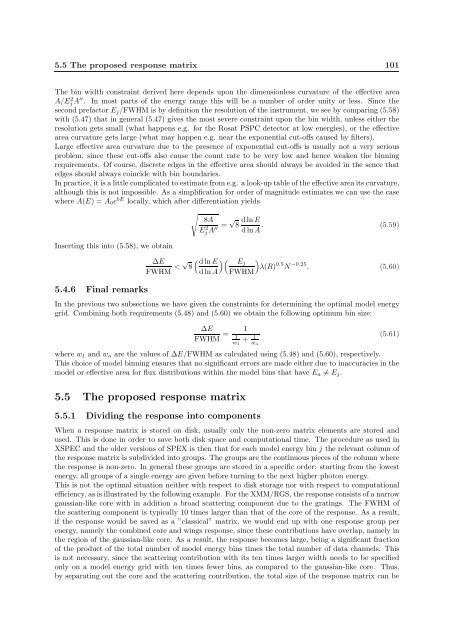SPEX User's Manual - SRON
SPEX User's Manual - SRON
SPEX User's Manual - SRON
Create successful ePaper yourself
Turn your PDF publications into a flip-book with our unique Google optimized e-Paper software.
5.5 The proposed response matrix 101<br />
The bin width constraint derived here depends upon the dimensionless curvature of the effective area<br />
A/Ej 2A′′ . In most parts of the energy range this will be a number of order unity or less. Since the<br />
second prefactor E j /FWHM is by definition the resolution of the instrument, we see by comparing (5.58)<br />
with (5.47) that in general (5.47) gives the most severe constraint upon the bin width, unless either the<br />
resolution gets small (what happens e.g. for the Rosat PSPC detector at low energies), or the effective<br />
area curvature gets large (what may happen e.g. near the exponential cut-offs caused by filters).<br />
Large effective area curvature due to the presence of exponential cut-offs is usually not a very serious<br />
problem, since these cut-offs also cause the count rate to be very low and hence weaken the binning<br />
requirements. Of course, discrete edges in the effective area should always be avoided in the sence that<br />
edges should always coincide with bin boundaries.<br />
In practice, it is a little complicated to estimate from e.g. a look-up table of the effective area its curvature,<br />
although this is not impossible. As a simplification for order of magnitude estimates we can use the case<br />
where A(E) = A 0 e bE locally, which after differentiation yields<br />
√<br />
8A<br />
Ej 2 = √ 8 d lnE<br />
A′′ d lnA . (5.59)<br />
Inserting this into (5.58), we obtain<br />
5.4.6 Final remarks<br />
∆E<br />
FWHM < √ 8<br />
( d lnE<br />
)(<br />
d lnA<br />
E j<br />
FWHM<br />
)<br />
λ(R) 0.5 N −0.25 . (5.60)<br />
In the previous two subsections we have given the constraints for determining the optimal model energy<br />
grid. Combining both requirements (5.48) and (5.60) we obtain the following optimum bin size:<br />
∆E<br />
FWHM = 1<br />
1<br />
w 1<br />
+ 1<br />
(5.61)<br />
w a<br />
where w 1 and w a are the values of ∆E/FWHM as calculated using (5.48) and (5.60), respectively.<br />
This choice of model binning ensures that no significant errors are made either due to inaccuracies in the<br />
model or effective area for flux distributions within the model bins that have E a ≠ E j .<br />
5.5 The proposed response matrix<br />
5.5.1 Dividing the response into components<br />
When a response matrix is stored on disk, usually only the non-zero matrix elements are stored and<br />
used. This is done in order to save both disk space and computational time. The procedure as used in<br />
XSPEC and the older versions of <strong>SPEX</strong> is then that for each model energy bin j the relevant column of<br />
the response matrix is subdivided into groups. The groups are the continuous pieces of the column where<br />
the response is non-zero. In general these groups are stored in a specific order: starting from the lowest<br />
energy, all groups of a single energy are given before turning to the next higher photon energy.<br />
This is not the optimal situation neither with respect to disk storage nor with respect to computational<br />
efficiency, as is illustrated by the following example. For the XMM/RGS, the response consists of a narrow<br />
gaussian-like core with in addition a broad scattering component due to the gratings. The FWHM of<br />
the scattering component is typically 10 times larger than that of the core of the response. As a result,<br />
if the response would be saved as a ”classical” matrix, we would end up with one response group per<br />
energy, namely the combined core and wings response, since these contributions have overlap, namely in<br />
the region of the gaussian-like core. As a result, the response becomes large, being a significant fraction<br />
of the product of the total number of model energy bins times the total number of data channels. This<br />
is not necessary, since the scattering contribution with its ten times larger width needs to be specified<br />
only on a model energy grid with ten times fewer bins, as compared to the gaussian-like core. Thus,<br />
by separating out the core and the scattering contribution, the total size of the response matrix can be

















